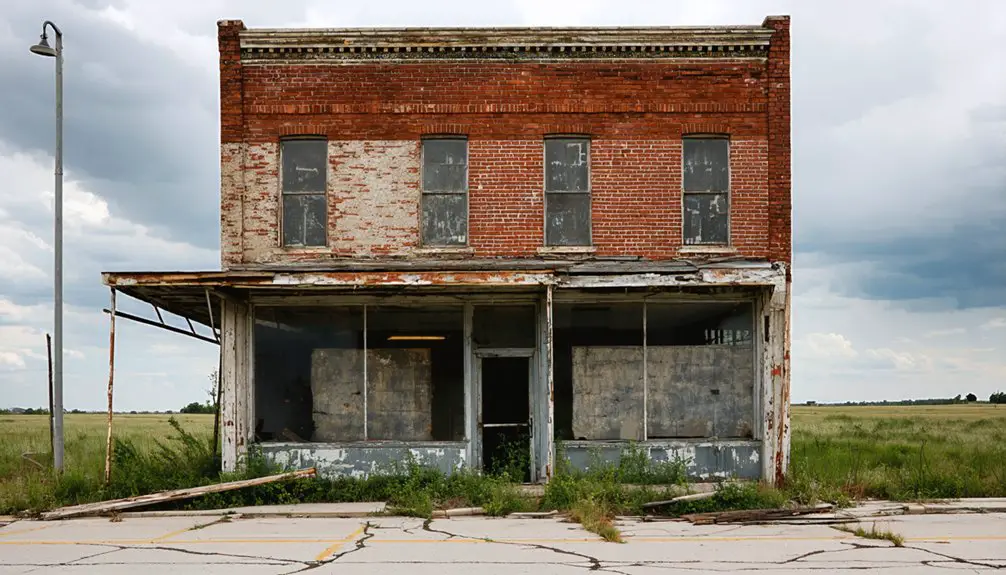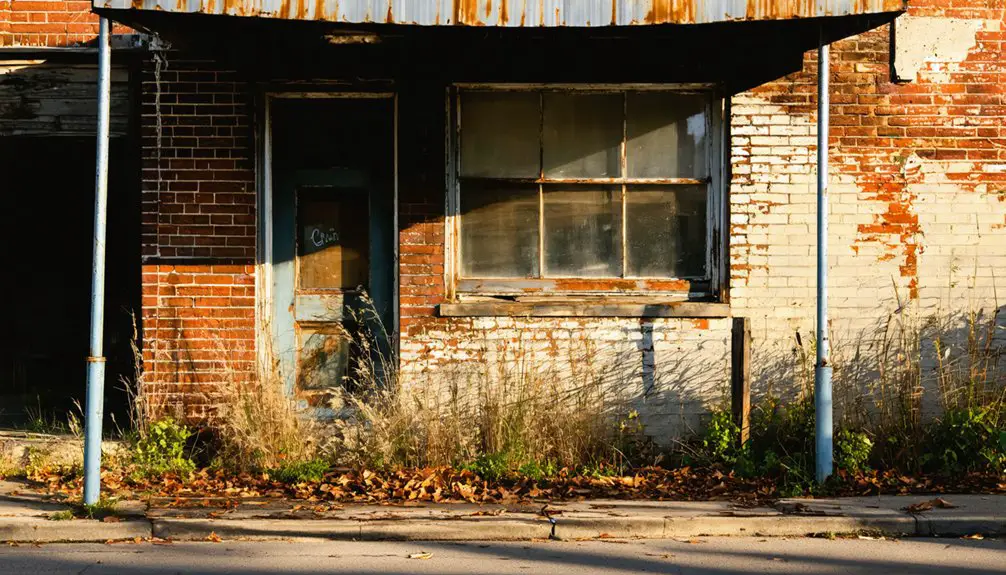You’ll find Indianapolis, Oklahoma’s remains as scattered ruins and foundations amid open fields today, though it began promisingly in the late 1800s. The town flourished briefly with the railroad’s arrival in 1902, attracting diverse settlers seeking economic opportunities. When the Great Depression hit, farm foreclosures and plummeting incomes forced mass exodus, with over 25% of residents losing jobs. The town’s transformation from boom to abandonment reveals deeper patterns in Oklahoma’s rural evolution.
Key Takeaways
- Indianapolis, Oklahoma was established in the late 19th century during Oklahoma Territory’s expansion and named after Indianapolis to attract settlers.
- The town’s economy initially thrived with the arrival of the railroad in 1902 but later declined when transportation routes bypassed the area.
- The Great Depression devastated the community, causing mass exodus as residents faced severe economic hardship and sought opportunities elsewhere.
- The town’s dependence on singular resource extraction and lack of economic diversification ultimately led to its complete abandonment.
- Today, only scattered ruins and foundations remain, with the site largely reclaimed by nature and agricultural development.
Early Settlement and Origins
When settlers first established Indianapolis, Oklahoma in the late 19th century, the town emerged as part of Oklahoma Territory’s broader expansion during a period of rapid development.
Like many frontier settlements of that era, settler motivations likely centered around economic opportunities tied to the region’s natural resources and strategic location along crucial transportation routes. The area attracted pioneers seeking profits from natural resource discoveries, as was common for Oklahoma’s estimated two thousand ghost towns. The arrival of the railroad in 1902 brought new opportunities for growth and commerce to the region.
Like many frontier settlements of that era, settler motivations likely centered around economic opportunities tied to the region’s natural resources and strategic location along crucial transportation routes.
The initial population probably included a diverse mix of traders, farmers, and workers drawn by the potential for growth.
While the exact circumstances of Indianapolis’s naming aren’t certain, it’s likely the founders chose it to evoke connections to the more established eastern city, hoping to attract additional settlers and investment to this new frontier community.
Life During Oklahoma’s Early Statehood
During Oklahoma’s changeover to statehood in 1907, Indianapolis residents witnessed dramatic political and social changes that reshaped their community’s landscape.
You’d have seen the impact of President Roosevelt’s proclamation establishing Oklahoma as the 46th state, which consolidated both Oklahoma and Indian Territories. The area’s cultural influences shifted as tribal governance structures adapted to new state frameworks, particularly affecting the Five Civilized Tribes who’d maintained significant political presence. The Curtis Act of 1898 had already set the stage for this transition by requiring the dissolution of tribal governments.
Your daily life would’ve been marked by rapid economic developments, especially with the discovery of oil at Glenn Pool near Tulsa in 1905. You might’ve participated in the expanding agricultural economy while watching new infrastructure emerge – roads, railroads, and educational institutions that served the growing population. The legacy of forced relocations from the Trail of Tears still influenced community relationships among Native American, white, and Black residents.
The establishment of county boundaries and local administration directly impacted how you’d interact with government services.
Economic Challenges and Population Shifts
As Indianapolis grew dependent on singular resource extraction, its economic fate became increasingly precarious.
You’ll find this pattern repeated throughout Oklahoma’s ghost towns, where communities built their foundations on temporary resource booms, only to face decline when those resources depleted.
Similar to the stagecoach route that once sustained Hindostan Falls, Indianapolis’s prosperity hinged on its accessibility to essential transportation networks.
The town’s challenges intensified as transportation routes evolved.
The story echoed towns like Boggy Depot, which vanished when rail lines bypassed their locations.
Like many Oklahoma communities, Indianapolis’s prosperity hinged on its accessibility to essential transportation networks.
When new transportation routes bypassed the area, you’d have seen a rapid exodus of residents seeking opportunities in better-connected towns.
The lack of economic diversification made it impossible for the community to adapt.
Without multiple industries to sustain it, Indianapolis couldn’t weather the changes that modernization brought, leading to its eventual abandonment.
The Impact of the Great Depression
As the Great Depression tightened its grip on Indianapolis, you’d have witnessed a mass exodus of residents who abandoned their farms and businesses in search of economic opportunities elsewhere.
You could track the town’s rapid decline through the wave of farm foreclosures that swept through the community, mirroring the broader pattern seen across Oklahoma where tenant farmers lost their livelihoods. Farm income plummeted by 64% during this devastating period, pushing many families to the brink of survival.
The town’s population shrank dramatically as desperate families loaded their belongings into vehicles and joined the broader migration of “Okies” seeking work in other states, particularly California. The economic devastation was so severe that by 1936, losses reached 25 million per day across the affected regions.
Economic Exodus Patterns
The Great Depression struck Indianapolis, Oklahoma with devastating force, triggering a mass exodus that would permanently alter the town’s demographic landscape.
You’ll find that economic migration patterns reflected the broader “Okie” exodus, as residents fled in search of opportunity elsewhere. With over 25% of Oklahomans losing their jobs and local farming income plummeting by 64%, community resilience was tested to its limits. Rural banks closed their doors after farmers defaulted on their loans.
The collapse of both agricultural and petroleum sectors left few alternatives for Indianapolis’s workforce. Soup kitchens became essential lifelines for many struggling families.
Bank failures wiped out family savings, while tenant farmers, who made up 60% of the agricultural population, were particularly vulnerable.
The town’s exodus mirrored other rural Oklahoma communities, where both temporary and permanent departures became common as local economies crumbled and relief programs proved insufficient.
Farm Foreclosures Sweep Town
Widespread farm foreclosures devastated Indianapolis’s agricultural foundation during the Great Depression, accelerating the town’s decline beyond the initial exodus of its workforce.
You’d have witnessed local farmers losing their properties for pennies on the dollar as eastern banks aggressively seized mortgaged lands, with some farms selling for less than 2% of their original value.
The foreclosure impact rippled through the community as country banks – once sympathetic to local conditions – failed and sold their mortgages to larger institutions.
You could’ve seen your neighbors struggling with plummeting crop prices, as cotton fell to six cents per pound and wheat to thirty-eight cents per bushel.
This farm displacement created a domino effect, forcing many residents into tenant farming or complete abandonment of their generational homesteads, fundamentally altering Indianapolis’s agricultural character.
Population Shrinks Rapidly
Dramatic unemployment swept through Indianapolis during the Great Depression‘s early years, with the city’s workforce shrinking by more than 25% below 1929 levels by late 1931.
Population trends reveal how manufacturing jobs plummeted from 59,000 to just 30,000 by 1933, forcing many residents to seek opportunities elsewhere. You’ll find evidence of community resilience eroding as construction permits and real estate activity virtually disappeared between 1931-1934.
The collapse of agriculture and oil industries intensified the exodus. With over 60% of farmers being tenants and farm income dropping 64%, rural families had little choice but to abandon their homes.
Despite attempts at public works projects and charity initiatives, Indianapolis’s population continued its steep decline as economic opportunities vanished, transforming a once-thriving town into a shadow of its former self.
Factors Leading to Abandonment
You’ll find that Indianapolis’s decline was heavily influenced by the devastating economic impact of the Great Depression in the 1930s, which triggered widespread unemployment and financial hardship throughout the community.
The town’s dependence on agriculture and railroad operations left it particularly vulnerable when both sectors experienced severe downturns during this period.
As residents sought better opportunities elsewhere, the resulting exodus created a self-perpetuating cycle of population loss that the town couldn’t recover from, even after the national economy improved.
Economic Depression Impact
The economic downfall of Indianapolis, Oklahoma, stemmed primarily from its heavy dependence on extractive industries and subsequent resource depletion. Without proper resource management or focus on economic sustainability, the town’s fate was sealed when its valuable minerals and petroleum reserves ran dry.
You’ll find that this single-industry dependence created a perfect storm when commodity prices collapsed, triggering a devastating chain reaction throughout the local economy.
As businesses supporting the extraction industry shuttered their doors, you could witness the rapid decline in employment opportunities and wages. The town’s ancillary services – from retail shops to housing markets – crumbled as workers fled to seek opportunities elsewhere.
This economic depression was particularly severe because Indianapolis hadn’t developed alternative industries to cushion the impact of its primary sector’s collapse.
Rural Population Migration
When examining Indianapolis’s transformation into a ghost town, multiple interrelated factors accelerated its population decline beyond simple economic hardship.
You’ll find that rural youth migration trends played a decisive role, as young residents sought economic opportunities in urban areas. Social determinants and infrastructure issues further intensified the community decline, creating a self-reinforcing cycle of departures.
- Demographic shifts hit particularly hard as working-age residents left, leaving an aging population with fewer services and declining healthcare access.
- Urban pull factors drew families away as schools closed and community amenities diminished.
- The lack of economic diversification and isolation from emerging markets made it increasingly difficult for remaining residents to sustain local businesses.
These migration patterns reflect broader rural-to-urban shifts that transformed many Oklahoma communities during this period.
What Remains Today

At Indianapolis’s former townsite today, visitors will find little evidence of the once-established community, as nature and agricultural development have largely reclaimed the area.
Time and nature have erased most traces of Indianapolis, leaving only whispers of the former townsite beneath reclaimed farmland.
You’ll discover only subtle traces of remaining structures, primarily foundations and scattered building ruins that require careful observation to detect. The landscape has transformed into open fields and pastures, with natural vegetation steadily overtaking any remnants of the town’s past.
If you’re planning to explore the site, don’t expect to find marked paths or historical markers.
The ghost town’s footprint has become nearly invisible, lacking paved roads or standing buildings. What you’ll encounter instead is an undeveloped rural setting where trees and grasses grow freely among the scattered ruins, making the site primarily interesting to dedicated ghost town researchers.
Historical Significance in Oklahoma
During Oklahoma’s territorial expansion in 1890, Indianapolis emerged as a strategic settlement alongside the burgeoning railroad network in Custer County.
You’ll find this ghost town’s story deeply woven into Oklahoma’s regional history, reflecting the dramatic shifts that shaped the state’s development from territory to statehood in 1907.
- The town’s establishment during contested territorial jurisdiction exemplified the complex political landscape of pre-statehood Oklahoma.
- Its connection to railroad infrastructure highlighted the critical role transportation played in early settlement patterns.
- The town’s eventual decline mirrors broader economic and demographic changes that transformed Oklahoma’s rural communities.
Indianapolis serves as a compelling case study of how economic booms, political changes, and shifting demographics influenced the fate of countless small towns during Oklahoma’s formative years.
Legacy and Documentation

The preservation of Indianapolis’s history extends far beyond its physical remains through thorough documentation in Oklahoma’s historical records.
You’ll find detailed ghost town archives spanning 1892-1922, including postmark records and John W. Morris’s extensive mapping efforts that captured the town’s layout, streets, and key structures.
The town’s documentary preservation continues through museum exhibits, particularly at the Oklahoma Route 66 Museum, where you can explore artifacts and photographs that tell Indianapolis’s story.
Academic research and digital databases maintain the town’s legacy, while cartographic records provide precise spatial documentation of buildings and community structures.
These preservation efforts guarantee that Indianapolis’s role in Oklahoma’s development, including its connection to frontier settlement patterns and economic shifts, remains accessible for future generations.
Frequently Asked Questions
Were There Any Notable Crimes or Mysterious Events in Indianapolis’s History?
You’d be intrigued by the unsolved mysteries surrounding nearby Osage murders, while crime legends of outlaw gangs and corrupt lawmen shaped this area’s violent past during oil boom days.
What Was the Peak Population of Indianapolis Before Its Abandonment?
You won’t find exact peak population records, but based on typical railroad town patterns and remaining evidence, it’s estimated the settlement likely housed between 100-300 residents before its Depression-era abandonment.
Did Any Famous People or Notable Families Live in Indianapolis?
You won’t find any famous residents or notable families documented in historical records. The town’s significance came solely from its railroad location rather than any prominent individuals or family lineages.
Are There Any Artifacts From Indianapolis Preserved in Oklahoma Museums?
While you might imagine dusty treasures behind glass, there’s no clear evidence of artifact preservation from Indianapolis in Oklahoma museums, though some items may exist within broader Route 66 ghost town exhibits.
What Native American Tribes Originally Inhabited the Indianapolis Area?
You’ll find the Miami were primary inhabitants, while Shawnee, Delaware, and Potawatomi tribes also shaped the area’s Native heritage. Their tribal influence extended through hunting grounds and settlements.
References
- https://en.wikipedia.org/wiki/List_of_ghost_towns_in_Oklahoma
- https://allthatsinteresting.com/picher-oklahoma
- https://www.youtube.com/watch?v=-jYN1_E2VV0
- https://www.ghosttowns.com/states/ok/indianapolis.html
- https://www.geotab.com/ghost-towns/
- https://www.okhistory.org/publications/enc/entry?entry=GH002
- https://www.youtube.com/watch?v=i6h5huyY4q0
- https://www.okhistory.org/publications/enc/entry?entry=ST025
- https://en.wikipedia.org/wiki/History_of_Oklahoma
- https://nationalcowboymuseum.org/explore/rushes-statehood-oklahoma-land-runs/



